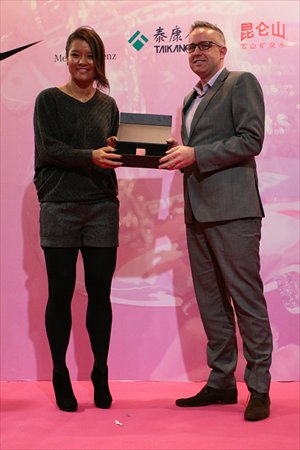Golden era coming

Li Na accepts a gift from Ryan Sandilands, Asia-Pacific CEO of the WTA, during the celebration of Li's Australian Open victory at the St. Regis Hotel in Beijing on February 22. Photo: Courtesy of IMG
The year 2014 has witnessed a huge step forward in Chinese women's tennis: In the singles, Li Na has risen to world No.2, while Peng Shuai claimed the world No.1 spot in the doubles.
Li, who made history for Chinese women's tennis by reaching the world No.3 spot last year after finishing second at the year-end WTA Championships in Istanbul, won her second Grand Slam title in January at the Australian Open in Melbourne Park, becoming the first Asian player to seize the singles world No.2 spot.
While Peng, paired with Hsieh Su-wei of Chinese Taipei, was stunned at the Australian Open, a strong show last season helped her to ascend to the doubles' world No.1 place. The duo won Wimbledon and the WTA Championships last year.
Hsieh also claimed her career-high doubles ranking of No.2 in the world - the highest ranking ever for a Chinese Taipei player.
The female players' success was echoed by the WTA events this year in China, with nine tournaments still to be held.
A matter of commitment
Rather than organizing sports teams and organizations to come to China every summer and play friendlies with second-tier players, the WTA made a commitment to China in 2008 and followed with specific action: In 2010, only two WTA events were held in China, but this year the number has grown to 10, including a Premier Mandatory event, the China Open, and a Premier 5 event, the Wuhan Open.
Ryan Sandilands, Asia-Pacific CEO of the WTA, said the commitment the WTA had made was one of the reasons he chose to join the women's tennis organization in September.
"As part of our strategy for Asia, we opened an office in 2008 and committed to growing the number of tournaments, expanding our fan base and working with key stakeholders to develop women's tennis in China. We strongly feel we've made good on that commitment," Sandilands told the Global Times in an exclusive interview.
While most of the events in China are not top-tier events, young athletes now have great opportunities to practice and grow domestically, and not have to exhaust themselves by traveling abroad to play.
They will start to enjoy "China time" from July, which starts in Nanchang in Jiangxi Province and culminates in Taipei in November.
Pulling down the barriers
Back in 2008 when the WTA opened an office in Beijing, only three Chinese players were in the top 100. Now, there are four in the top 60.
It cannot be denied that Li's success spearheaded the boom in Chinese women's tennis, with more and more young players picking up their rackets after Li's astonishing performances in the world.
While some regard tennis as a sport for the rich in China, tennis itself has seen a big improvement in the last five years, highlighted by the growing number of women's tennis fans in the Asia-Pacific, from four million in 2010 to 14 million in 2014.
"Things are going really well before me. My job is to continue that trajectory … It's all about continuing to grow, look at what's working and make sure we can continue that, adapting to what tennis fans want," Sandilands said.
Previously, Chinese children did not have much choice when choosing a sport, but now, they have one more: tennis.
"We feel tennis is a very accessible sport, if there's barriers to the sport, especially participation in playing the sport, it's our responsibility to bring down those barriers, and work hand in hand with municipal governments and sports bureaus to let people have the chance to play," Sandilands said.
"For some people their love of tennis may not be based on playing but just on watching. [Let them] follow their role models. For those who want to pick up a racket and hit some balls, we have to try to bring down those barriers too, to make them able to do that."
More tennis festivals and activities will take place around the tournaments in China, according to Sandilands.
"To encourage people to come along and learn about the game, and make sure they're accessible to everyone for free, we will provide them with rackets, balls and set up courts," Sandilands revealed.
Promising year-ender
The season finale, the WTA Championships, has moved to Asia for the first time as this year's event will take place in Singapore in October. The top eight singles players and top eight doubles pairs of the year gathered to play in the round robin event, and each is regarded as a potential Grand Slam final.
This season's year-ender will feature some new events: the Rising Stars Exhibition, Legends Exhibition and Future Stars tournament, to give more people the chance to enjoy the 10-day event.
Chinese tennis fans will be able to watch top-tier matches without staying up late at night as Singapore is in the same time zone as Beijing. If the Chinese women's players can keep their good form for the whole year, fans will be elated to see a potential Chinese champion.
"Singapore will be a great show, not only for Singapore but also an event for Asia. They generate passion from citizens who are interested and who want to be part of it," Sandilands said.
"This is a major event for us. It's equivalent to a Grand Slam, it's happening in Asia, and has a strong Chinese component."